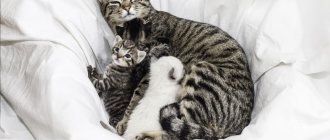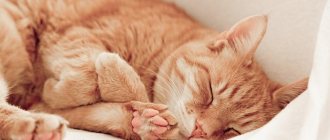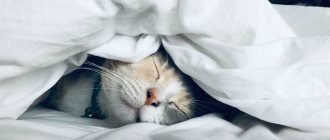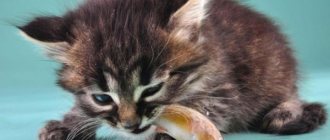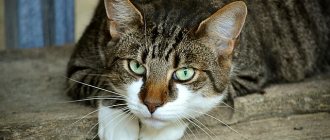13044Administration
If your cat has a planned or accidental mating, it is important to determine as early as possible whether fertilization has begun - doing this without the help of a specialist is not always easy, but it is still useful to know what signs of a cat’s pregnancy indicate that your pet will soon become a mother .
The earlier pregnancy is established, the more time the owners will have to prepare for the appearance of the offspring. This is especially important for purebred animals - after all, some breeds have difficulties in bearing and giving birth to offspring, and they may require the supervision and assistance of a veterinarian.
Puberty of cats
The onset of puberty depends on belonging to a particular breed. For example, Siamese and Balinese ripen earlier. Representatives of large-bodied breeds, Maine Coon and Scottish Straight, are distinguished by late maturation. Physiological maturity also depends on the time of birth of the kitten. Those born in summer become sexually mature faster than in winter.
During the maturation period, the so-called “cat” songs begin. These are gentle meows and uterine sounds that communicate intentions. Such “concerts” can last a long time . The cats become overly affectionate and loving. They constantly clean themselves up and mark their territory. They often rub against the owner's legs and the legs of tables and chairs. A caring owner understands that it is time for the pet to look for a partner. But when your cat is in heat for the first time, you should not pair her with a male cat. Puberty does not yet indicate the complete physical development of an animal.
The body's readiness to bear healthy kittens occurs at fourteen months.
It happens that a cat demands a cat, but due to her age she is not yet ready for pregnancy. In this case, on the advice of a veterinarian, you can reduce libido with medications. This will calm your pet, and she will stop asking to go outside. The owner will protect himself from unplanned mating and the associated unwanted pregnancy of the cat. During courtship, cats receive multiple wounds in fights with rivals. After running away from home, pets can return infected with various diseases, including parasites. Therefore, during the period of heat, owners should carefully monitor their pets.
How do you know if your cat is pregnant?
A cat's pregnancy can be recognized by changes in behavior, and a veterinarian will help to accurately determine the fact of pregnancy. Around the 21st day after conception, he can feel if there is a fetus in the uterus.
However, there are symptoms that will tell you that your cat will soon have kittens: changes in the mammary glands, fatigue, toxicosis and more frequent urination are all signs that your cat is expecting offspring.
Changes in the mammary glands
This symptom usually accompanies the first pregnancy in cats. The duration of uncharacteristic behavior for a cat can vary, so you may not think anything of it at first, but redness and swelling of the nipples should alert you. If your nipples feel hot, your cat may be pregnant.
Fatigue
Drowsiness, lethargy, reluctance to run and frolic... Is this really the same cat that loves to play so much? Days of pregnancy can change your pet's behavior, and fatigue is one of the signs.
Toxicosis
Early pregnancy in cats can be accompanied by toxicosis. Nervousness, poor appetite, morning vomiting - toxicosis is unpleasant, but safe for the cat and its offspring. Make sure that these signs are not accompanied by diarrhea and dehydration - in this case, the cat should be shown to a veterinarian.
More frequent urination
During pregnancy, cats may empty their bladder more often than usual. If the urine is clean, free of blood, and the process of urination is painless and does not cause anxiety in the cat, then everything is in order with its health.
Features of the first mating
During the first heat, it is advisable to isolate a teenage cat from contact with the opposite sex. This must be monitored especially carefully if she has free access to the street, which most often happens in private houses. Before the body is fully formed, any pregnancy should be excluded. Kittens born to a young mother have health problems. The life of the cat itself is jeopardized by early birth. Therefore, for the well-being of her and future kittens, it is advisable to pair her with a male cat after the second or third heat.
Representatives of some breeds are bred for the first time at one and a half years old. Before this, you need to show the cat to the veterinarian . It will determine how mature the pet’s body is to bear healthy offspring. It may be necessary to compensate for the lack of vitamins and microelements before the impending pregnancy. All necessary vaccinations must be completed. Also, if necessary, the veterinary clinic will treat your cat for diseases and parasites. Prescribed drugs cannot be taken during pregnancy, so all treatment is carried out before the expected event.
When can a cat become pregnant for the first time?
A cat's first heat period occurs at the age of six months, at which point the cat can become pregnant and begin bearing kittens. Mating of purebred animals is prescribed for the period when they are a year and a half old. At this time, the cat becomes fully sexually mature and ready to give birth to healthy and strong offspring. If a cat carries kittens at an early age, this can negatively affect her health and well-being, the quality of subsequent pregnancies and procreation in general.
© shutterstock
Experienced breeders recommend that all owners wait until two or three times before breeding cats.
It is important that the first pregnancy occurs at the moment when the female has fully matured, that is, simultaneously from a physiological and psychological point of view. After all, in cats, as in people, the appearance of offspring is associated not only with physiology, but also with the psychology of the animal. If pregnancy does not occur after the first coating, then you can bring the female and male together again before a positive result is achieved.
Initial signs
It is difficult to find out if a cat is pregnant at first.
Symptoms that indicate that she is expecting offspring appear after 3-4 weeks:
- behavior becomes calm. The cat sleeps constantly;
- some feel weak, and occasionally you may notice that the animal is vomiting;
- appetite and food preferences change;
- becomes aggressive towards the opposite sex: hisses and arches his back;
- after 20 days the nipples turn pink;
- at four weeks, when stroking the cat, you can notice the cubs moving;
- at 5-6 weeks the belly becomes large;
- a cat's weight increases 1.5 times during pregnancy;
- 10-14 days before birth, the search for a place to build a nest begins.
At the veterinary clinic, ultrasounds are performed to determine how long the cat will bear kittens. The study is carried out two weeks after mating.
After 10 days, its presence can be determined by palpation. This procedure is carried out within a matter of days. Then it will be difficult to palpate the cubs due to the large amount of amniotic fluid in the uterus.
Adviсe
Finally, some useful tips for owners of pregnant cats.
- A pregnant cat should eat well. If you feed your cat dry food, switch to the same brand for pregnant and lactating cats.
- Do not self-medicate and do not give your pet any medications or vitamin supplements without a veterinarian’s prescription.
- If you have other cats, limit their contact with the pregnant woman. Animals in position love privacy.
- Limit walks outside, especially in the last stages of pregnancy, when the cat is especially vulnerable and cannot fend for itself. Also, giving birth on the street should not be allowed.
- Do not allow the animal to climb at heights. A cat with a big belly is clumsy, and falling is very dangerous.
- Prepare the nest for the upcoming birth.
- Find out in advance the phone numbers and addresses of the nearest veterinary clinics in case of complications.
- Don't forget how long a cat's pregnancy normally lasts, and consult a doctor if 70 days or more have passed since conception.
Duration of pregnancy
No one can accurately predict how many days cats carry kittens. But the approximate period lasts about 9 weeks. There is a deviation of 5 days in one direction or another. Premature babies are born weak and non-viable. Post-term pregnancy is also unfavorable for the health of the babies. But it happens that they are born healthy, without pathologies, even if they deviate from the gestational age. This is possible with a special balanced diet and good conditions for keeping the pet. If pregnancy is delayed by one week, you should contact your veterinarian.
It is believed that the period can be determined by the breed.
But it can also depend on the length of the animal’s fur:
- According to this theory, short-haired representatives give birth to kittens a week before the usual due date. These include sphinxes and orientals. This is due to rapid metabolic processes in the body. Naturally, this also affects the early development of the fetus. The kittens will be born healthy;
- cats with medium length hair, such as Siamese, Burmese and Scottish, give birth to kittens 3-5 days before the standard gestation period;
- Representatives of long-haired breeds bear their young the longest. These are Maine Coons, Persian and Siberian.
Before giving birth, your cat is unusually restless. Attentive owners should not lose sight of their pet.
By this time, the delivery area should be prepared. Otherwise, the cat will find it herself, for example, a closet with clothes, a laundry basket or a bed.
Features of pregnancy in cats
A cat is capable of conceiving as early as 7–8 months, but the optimal age for the first pregnancy is considered to be from one to one and a half years. By this time, the young body will become stronger physically and mentally, the cat will go through 2-3 heats, after which the hormonal status will be completely established.
Mating a cat during her first heat will undermine the health of the animal, especially a purebred one.
The reproductive age of a cat lasts a long time, since the ability to fertilize is retained in these animals until old age. Theoretically, she can become pregnant and give birth to kittens before the age of 15–20 years. But in practice this is rather an exception to the rule, since by this time the cat usually has health problems. If pregnancy occurs at this age, it will be problematic and require constant monitoring by a veterinarian.
Provided ovulation has taken place, a cat can become pregnant even at a fairly old age (10–15 years)
Cats go into heat throughout their lives, but with age, the time interval between them increases. The oldest cat to give birth to kittens is Kitty from Great Britain; she became a mother at the age of 30, bringing her owner two cubs. During her long life, Kitty managed to give birth to 218 kittens.
A cat's estrus lasts one to two weeks, and the number of estruses per year depends on many factors:
- light mode;
- genetics;
- animal breeds;
- food quality;
- presence of a male in the house.
On average, a cat “walks” once every three months, and with regular fertilization and bearing kittens - once every six months.
The estrus process is divided into three phases:
- Preparation for mating (proestrus) - the cat becomes more affectionate and sociable than usual, the phase lasts 1-3 days.
- Estrus (estrus) - screams, marks, loss of appetite, characteristic poses. Duration 7–10 days.
- Calm (interestrus) - normalization of behavior until the next heat.
During heat, the cat takes a characteristic pose, calling the cat
A cat can give birth to 1 to 10 kittens at a time, but most often has 3 to 5 cubs.
The record for the number of kittens listed in the Guinness Book is still held by the Siamese cat Antigone from the USA, who gave birth to 19 babies at once in 1970. Unfortunately, only 15 of her litter survived. Bluebell, a South African cat, gave birth to 14 kittens in 1974, all of which survived.
Most often, a cat gives birth to 3 to 5 cubs, and a litter of 10–11 kittens is already considered a rarity
A cat's uterus is shaped like a Y and includes a body and two long horns. During pregnancy, these horns increase their thickness to 2–2.5 cm and can contain up to 6–7 fetuses each. The embryos are evenly spaced, separated from each other by membranes, and therefore a multiple pregnancy does not threaten the life and health of the pet.
A feature of the cat’s uterus is the presence of two sections (horns), in which embryos can be located independently of each other.
The gestation period for kittens depends on many factors, such as:
- cat's heredity;
- breed;
- age;
- complexion;
- number of fruits.
On average, pregnancy in cats lasts from 60 to 65 days. The minimum acceptable threshold is 58 days, the maximum is 71. In practice, the following interesting facts have been revealed about the duration of pregnancy in cats:
- the more fetuses a cat has, the faster the birth will occur;
- thin cats give birth faster than overweight cats;
- outbred cats bear kittens faster than purebred cats and are able to give birth to healthy offspring prematurely;
- the first pregnancy of cats, especially those that occur at too young an age (less than 1 year), often ends in premature birth and weak offspring;
- Short-haired breeds, such as Russian Blues, Abyssinians, Devon Rex, give birth to kittens 4-5 days earlier than long-haired breeds - Norwegian, Siberian, Neva Masquerade.
The cat's health status directly depends on the number of births. The maximum number of pregnancies for an animal is 4–5 per year. However, in such an extreme regime, the body does not have time to fully recover and prepare for the next birth. In practice, this often occurs in mongrel cats, as a result of which their health deteriorates and their life expectancy is greatly reduced. For complete recovery, especially after childbirth with complications, the body will need at least 10 months.
The owner should not allow the animal to become pregnant so often. If it is not possible to control this process (for example, the cat walks outside on its own), then it would be better to sterilize the animal.
Responsible breeders of valuable breeds adhere to the rule that a cat cannot have more than 3 births within 2 years.
Table: course of pregnancy by week
| Term | Development of pregnancy | Cat behavior |
| 0–7 days | Mating, ovulation, fertilization of the egg, movement of zygotes into the uterus, attachment to the walls (implantation) | Slight decrease in activity, decreased or increased appetite |
| 8–21 days | Formation of the placenta, which will protect and nourish the kittens. Embryos have a visible head and tail. | Lethargy, passivity, poor appetite, possible mild toxicosis, vomiting |
| 22–28 days | The fertilized eggs grow and reach a size of 20 mm, the internal organs, brain and heart of the embryos develop, and on ultrasound you can hear their heartbeat - 230 beats per minute. | The cat's belly becomes denser, her nipples turn pink, she sleeps a lot, tries to stay closer to the owner |
| 29–42 days | Embryos develop fur, claws form on their paws, sensory organs, muscles, nervous system, and bones develop. The kittens begin to move. Sizes from 4 to 6 cm. | The abdomen becomes rounded, the female becomes heavier, during palpation the embryos can be felt and their movements can be felt. The cat eats and sleeps a lot, moves more carefully, and sometimes protests against examining its abdomen (protects its cubs). |
| 43–56 days | The formation of fur ends, the bones and spine are clearly visible on the X-ray, the embryos already look like kittens with short legs and a tail and begin to practice reflexes of breathing, sucking, and hiccups | The belly is growing quickly, the cat often goes to the toilet, sleeps a lot, eats often, but little by little. The kittens' movements in their stomachs are clearly visible. |
| 53–63 days | Kittens grow up to 13 cm in length, weigh about 100 grams each, and test contractions of the uterus begin. By 60 days from conception, the fetuses are completely ready for birth. | The stomach sags and moves back towards the hips. The appetite decreases, the cat gets worried, looks for a place for a nest and settles in it. |
After 40 days of development, the embryos become more and more like kittens, they even develop claws and fur.
Video: cat life before birth
Main stages
The process of forming kittens from conception to birth is quite complex.
The following important stages of their development during pregnancy are distinguished:
- The first stage covers a month after mating the animal. Hormonal changes occur in the body. This affects character and behavior. The cat becomes affectionate and calm. Her nipples swell and their color changes. The process of embryo formation begins in utero.
- The second stage includes 5-6 weeks of pregnancy. The pet is sleeping at this time and needs a sufficient supply of food. The future offspring develops intensively inside the mother. This can be seen as the cat's belly size and weight increase.
- At the next stage, the future kittens are formed. They gain weight and become active, which causes the abdomen to sag. The cat changes dramatically: the maternal instinct awakens. She prefers to be with small children if there are any in the house.
- The time of formation of fur in cubs is difficult. During this period, all internal systems of the body are launched. Due to the increased intensity of metabolic processes, the excretory function increases. This affects the condition of the expectant mother. Her appetite decreases, which can lead to a complete refusal of food.
- The last stage begins at 8 weeks. Future kittens are quite large. The mother cat may have urinary incontinence. 1-2 days before lambing, she becomes restless and begins to look for a place where she can give birth to kittens.
Changes in a pregnant cat's behavior
In the first week, when your beloved pet becomes pregnant, there may not be any significant changes in its habits, but activity decreases slightly and the animal often goes to sleep.
At the same time, the animal eagerly makes contact with its owners, asks to be petted and climbs into their arms. There may be an increase in appetite - the animal constantly asks for food, and does this with great persistence. At 5–7 weeks, the kittens begin to move imperceptibly in the mother’s womb.
A couple of days before the kittens appear, the animal shows special care and attentiveness, starting to lick the owners or other inhabitants of the apartment in every possible way, showing concern for them.
Naturally, such changes are not inherent in all cats, which is primarily due to the individual characteristics of the animal. On the day when childbirth occurs, the pet becomes restless, unable to find a place for itself.
Estrus during gestation
There are cases of estrus occurring during pregnancy. This occurs in one in ten cats. Most often this happens at 3-6 weeks. If at this time there was mating with a male, then secondary conception occurs. The newly fertilized egg is implanted in the uterus. Embryos also develop from it. At birth, these offspring turn out to be premature compared to those already formed. In most cases it dies. Kittens of the second conception sometimes remain in the uterus and may be born a week after the first.
What if the kittens don't move?
The babies push and move, which means the pregnancy is proceeding smoothly and the cat will soon give birth, but it happens, on the contrary, when the tummy is round and no movement is visible at the right time. There may be a normal explanation for this. Active actions can be observed several days before the onset of labor, if the pet has a well-fed or large build, and there are 1-2 fluffies in the womb, then the kittens are located mainly under the sternum, which is high and it is difficult to observe their movement. In addition, in different breeds of cats, movement begins later by a week or 2, especially if the exact date of mating is unknown.
Gestation period and number of kittens
Owners are concerned about the effect of the number of offspring on the duration of pregnancy. Although there is no scientific confirmation of this, it is still noted that the more kittens, the shorter the gestation period. In this way, nature protects the mother’s body from exhaustion. The variation in the number of kittens is quite large. This is influenced by many factors, the main one of which is the physiological characteristics of the animal.
The length and number of kittens a cat bears depends on the breed.
For example, the Siamese breed is characterized by multiple births: up to 13 babies are born in one lamb. Gestation time is 8-9 weeks. Large breed cats give birth to four kittens, which last a long time. The female of the Scottish breed carries her offspring from 8 to 10 weeks.
Also, the number of cubs depends on the age of the pet. A first-time cat gives birth to 1-3 kittens; her body is not yet ready for multiple pregnancies. In the future, she can bear up to 6 cubs. An aging cat may give birth to one or two kittens.
